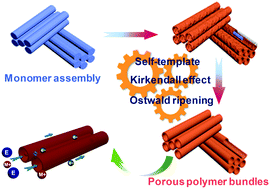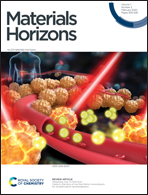A monomer-assembly template-directed synthesis of conjugated porous polymer microtubular bundles†
Abstract
For porous organic materials, the defined morphology in the micrometre or a larger scale plays an extremely important role in fully exhibiting their molecular-level properties in the bulk phase, thus tuning the synergetic effects of different components and facilitating their fabrication and processing. However, the synthetic strategy towards porous organic materials with well-controlled morphologies is still very limited and full of challenges. Herein, we report a simple self-templated method to construct conjugated porous polymer microtubular bundles in the fused fashion. In the synthesis processes, the monomer 1,3,5-benzene-tricarbohydrazide is firstly assembled into crystalline microfiber bundles as the template, which is then condensed with 1,7-para-formylphenyl-perylene-3,4,9,10-tetracarboxylic diimide via the dynamic covalent acylhydrazon linkage. Upon a quasi-Kirkendall effect and Ostwald ripening process, a conjugated porous polymer featuring smooth microtubular bundles can be essentially constructed. Such defined hierarchical morphology exhibits the substantial co-used tubular walls and orientated channels with sub-micrometre-sized diameters and lengths in tens of micrometers, thus rendering an extremely high accessibility of their redox active sites.



 Please wait while we load your content...
Please wait while we load your content...